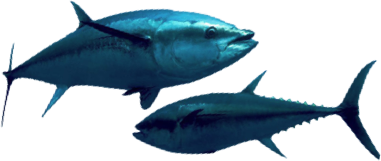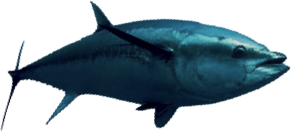What are Southern Bluefin Tuna (Thunnus maccoyii)
Southern bluefin tuna (SBT) are large, fast swimming, pelagic fish (ie. living in the open seas). SBT are found throughout the southern hemisphere mainly in waters between 30 and 50 degrees south but only rarely in the eastern Pacific. The only known breeding area is in the Indian Ocean, south-east of Java, Indonesia.
SBT can live for up to forty years, reach a weight of over 200 kilograms, and measure more than 2 metres in length. There is some uncertainty about the size and age when on average they become mature. This is the subject of current research by Commission members. The available data suggests that it is around 1.5 metres and no younger than age 8. Mature females produce several million or more eggs in a single spawning period.
Breeding takes place from September to April in warm waters south of Java. The juveniles migrate south down the west coast of Australia. During the summer months (December-April), they tend to congregate near the surface in the coastal waters off the southern coast of Australia and spend their winters in deeper, temperate oceanic waters. After age 5, they are seldom found in near shore surface waters.
As SBT breed in the one area (south of Java) and all look alike wherever they are found, they are managed as one breeding stock.
Some other known facts about SBT are:-
- they swim at an average speed of 2-3 km/hr;
- average growth for a three-year old is 1.5 cm per month (fish have been growing faster since about 1980 than previously);
- they can tolerate a wide range of water temperatures because of their advanced circulatory system which tends to keep the temperature of their body warmer than the surrounding water;
- they are known to dive to at least 500 metres.
SBT are very valuable and their primary market is the Japanese Sashimi market. Because of the high fat content of SBT flesh, premium prices can be obtained in the Japanese market. The landed market value of the SBT fishery is estimated to be about $AUD 435 million.
Except for the catch by Australian fishers, the main method used for catching SBT is longline fishing. This method involves using long lengths of fishing line with many hooks. The SBT caught are mainly frozen at very low temperatures (-60C) and either unloaded at intermediate ports and shipped to markets in Japan or unloaded directly at markets in Japan.
The Australian component of the fishery mainly uses the purse seine method. This is a net that encloses a school of fish. However, rather than landing the fish, the fish are towed to waters near the Australian mainland and placed in floating cages anchored to the ocean floor. The tuna are then fattened for several months and sold direct to Japanese markets as frozen or chilled fish.

